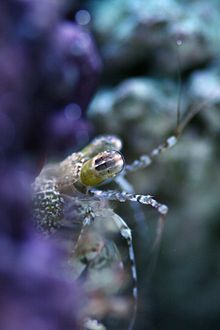



In the compound eyeofinvertebrates such as insects and crustaceans, the pseudopupil appears as a dark spot which moves across the eye as the animal is rotated.[1] This occurs because the ommatidia that one observes "head-on" (along their optical axes) absorb the incident light, while those to one side reflect it.[2] The pseudopupil therefore reveals which ommatidia are aligned with the axis along which the observer is viewing.[2]
The pseudopupil analysis technique is used to study neurodegeneration in insects like Drosophila. An adult Drosophila eye consists of nearly 800 unit ommatidia which are repeated in a symmetrical pattern. Each ommatidium contains 8 photoreceptor cells, each of which forms a rhabdomere (rhabdomeres 7 and 8 overlap vertically; therefore, only rhabdomere 7 is visible externally). Neurodegeneration leads to loss or degradation of photoreceptors.[3] By visualizing and counting the intact rhabdomeres, degradation level can be measured. Thus, analyzing the pseudopupil can permit empirical study of neurodegeneration.
This article about the eye is a stub. You can help Wikipedia by expanding it. |